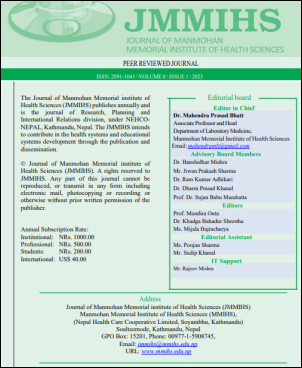Behavioral Risk Factors of Non-Communicable Diseases (NCDs) amoung Secondary and Undergraduate Level Students of Kathmandu Metropolitan City
DOI:
https://doi.org/10.3126/jmmihs.v8i1.57269Keywords:
Behavioral risk factors, Non-communicable diseases, Youths, KathmanduAbstract
Background: Most NCDs are strongly associated and causally linked with four particular behavioral risk factors: tobacco use, physical inactivity, unhealthy diet, and the harmful use of alcohol. The prevalence of NCDs is related to unhealthy behaviors and practices typically initiated in adolescence.
Objective: The objective of the study was to assess the occurrence of behavioral risk factors associated with NCDs among secondary and undergraduate level students of Kathmandu Metropolitan City through identification of risk of smoking and alcohol, consumption of fruits and vegetables and level of physical activities.
Materials and Methods: A quantitative cross sectional descriptive study was done from September to December, 2015 among 249 youths of age 14-28 years studying at various school and colleges in Kathmandu Metropolitan city.
Results: The study findings were that 15.6% were smoker, 32.53% alcohol users, 38.96% consumed fruits at least once a day with mean 1.74 serving, 83.53% consumed vegetables at least once a day with mean 2.69 serving, 22.49% and 36.95% doing vigorous and moderate intensity physical activity at least 3 or more times in a week, 30 minutes at a time. The Chi-square test showed the association of sex of participants, age group of participants, permanent residence, living with family, studying in public and private school/college and family income with different behavioral risk factors.
Conclusion: The study showed high proportions of participants were at risk of developing NCDs. Male were found to be harmful use of alcohol and smoking, and consuming less fruits and vegetables, and female were found to be doing less physical activity. Both male and female were at higher risk, but their behavioral risk seemed to be different according to the sex difference.
Downloads
Downloads
Published
How to Cite
Issue
Section
License
© Journal of Manmohan Memorial Institute of Health Sciences (JMMIHS)
All rights reserved to JMMIHS. Any part of this journal cannot be reproduced, or transmitted in any form including electronic mail, photocopying or recording or otherwise without prior written permission of the publisher.




